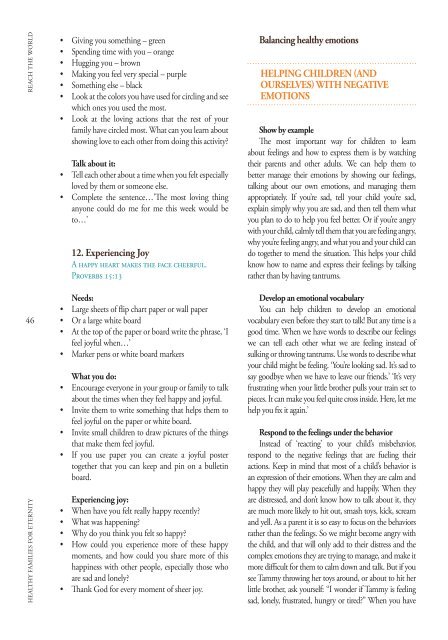HEALTHY FAMILIES FOR ETERNITY
FM_Planbook%202016-eng
FM_Planbook%202016-eng
Create successful ePaper yourself
Turn your PDF publications into a flip-book with our unique Google optimized e-Paper software.
<strong>HEALTHY</strong> <strong>FAMILIES</strong> <strong>FOR</strong> <strong>ETERNITY</strong> REACH THE WORLD<br />
46<br />
• Giving you something – green<br />
• Spending time with you – orange<br />
• Hugging you – brown<br />
• Making you feel very special – purple<br />
• Something else – black<br />
• Look at the colors you have used for circling and see<br />
which ones you used the most.<br />
• Look at the loving actions that the rest of your<br />
family have circled most. What can you learn about<br />
showing love to each other from doing this activity?<br />
Talk about it:<br />
• Tell each other about a time when you felt especially<br />
loved by them or someone else.<br />
• Complete the sentence…’The most loving thing<br />
anyone could do me for me this week would be<br />
to…’<br />
12. Experiencing Joy<br />
A happy heart makes the face cheerful.<br />
Proverbs 15:13<br />
Needs:<br />
• Large sheets of flip chart paper or wall paper<br />
• Or a large white board<br />
• At the top of the paper or board write the phrase, ‘I<br />
feel joyful when…’<br />
• Marker pens or white board markers<br />
What you do:<br />
• Encourage everyone in your group or family to talk<br />
about the times when they feel happy and joyful.<br />
• Invite them to write something that helps them to<br />
feel joyful on the paper or white board.<br />
• Invite small children to draw pictures of the things<br />
that make them feel joyful.<br />
• If you use paper you can create a joyful poster<br />
together that you can keep and pin on a bulletin<br />
board.<br />
Experiencing joy:<br />
• When have you felt really happy recently?<br />
• What was happening?<br />
• Why do you think you felt so happy?<br />
• How could you experience more of these happy<br />
moments, and how could you share more of this<br />
happiness with other people, especially those who<br />
are sad and lonely?<br />
• Thank God for every moment of sheer joy.<br />
Balancing healthy emotions<br />
HELPING CHILDREN (AND<br />
OURSELVES) WITH NEGATIVE<br />
EMOTIONS<br />
Show by example<br />
The most important way for children to learn<br />
about feelings and how to express them is by watching<br />
their parents and other adults. We can help them to<br />
better manage their emotions by showing our feelings,<br />
talking about our own emotions, and managing them<br />
appropriately. If you’re sad, tell your child you’re sad,<br />
explain simply why you are sad, and then tell them what<br />
you plan to do to help you feel better. Or if you’re angry<br />
with your child, calmly tell them that you are feeling angry,<br />
why you’re feeling angry, and what you and your child can<br />
do together to mend the situation. This helps your child<br />
know how to name and express their feelings by talking<br />
rather than by having tantrums.<br />
Develop an emotional vocabulary<br />
You can help children to develop an emotional<br />
vocabulary even before they start to talk! But any time is a<br />
good time. When we have words to describe our feelings<br />
we can tell each other what we are feeling instead of<br />
sulking or throwing tantrums. Use words to describe what<br />
your child might be feeling. ‘You’re looking sad. It’s sad to<br />
say goodbye when we have to leave our friends.’ ‘It’s very<br />
frustrating when your little brother pulls your train set to<br />
pieces. It can make you feel quite cross inside. Here, let me<br />
help you fix it again.’<br />
Respond to the feelings under the behavior<br />
Instead of ‘reacting’ to your child’s misbehavior,<br />
respond to the negative feelings that are fueling their<br />
actions. Keep in mind that most of a child’s behavior is<br />
an expression of their emotions. When they are calm and<br />
happy they will play peacefully and happily. When they<br />
are distressed, and don’t know how to talk about it, they<br />
are much more likely to hit out, smash toys, kick, scream<br />
and yell. As a parent it is so easy to focus on the behaviors<br />
rather than the feelings. So we might become angry with<br />
the child, and that will only add to their distress and the<br />
complex emotions they are trying to manage, and make it<br />
more difficult for them to calm down and talk. But if you<br />
see Tammy throwing her toys around, or about to hit her<br />
little brother, ask yourself: “I wonder if Tammy is feeling<br />
sad, lonely, frustrated, hungry or tired?” When you have


